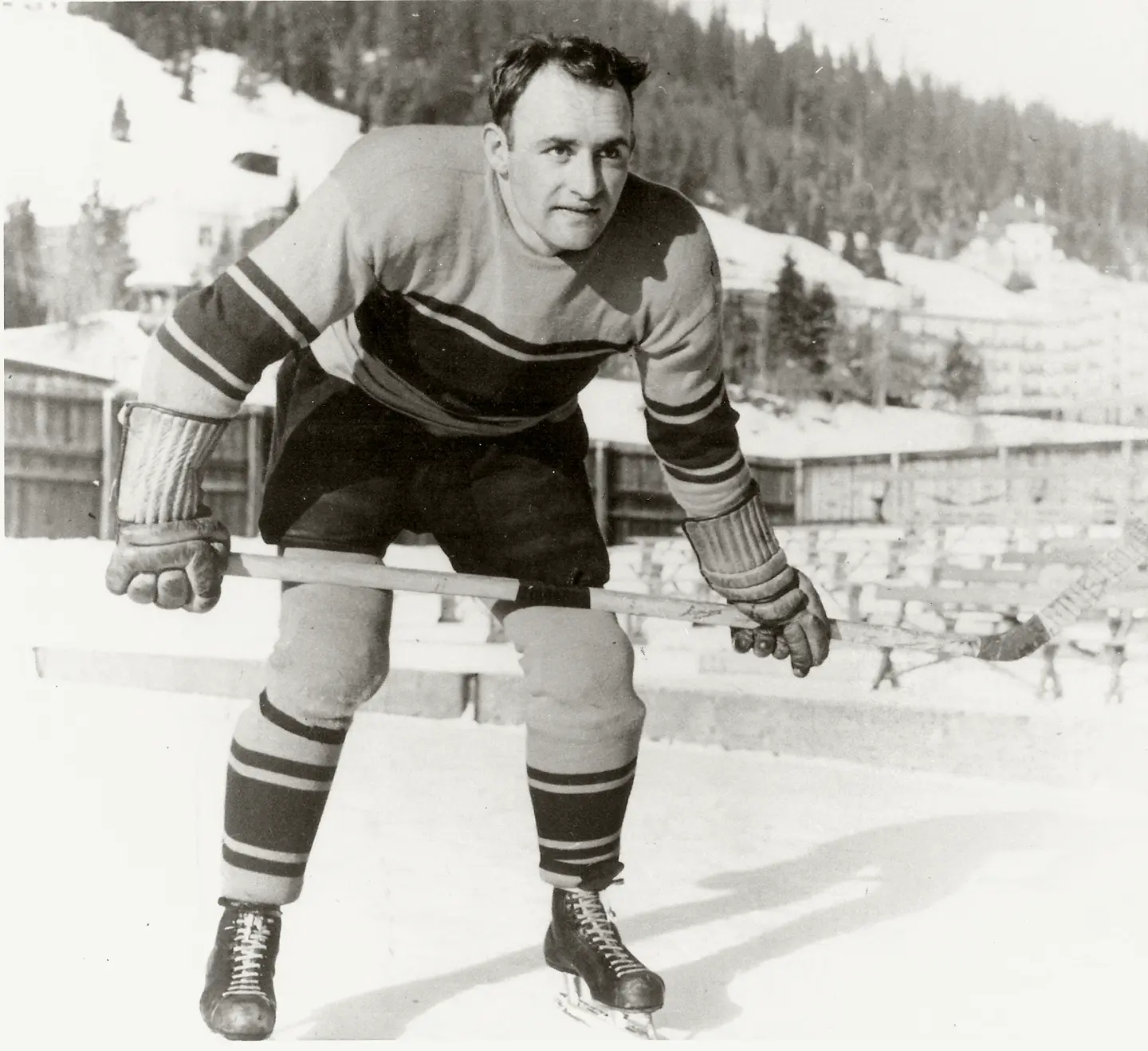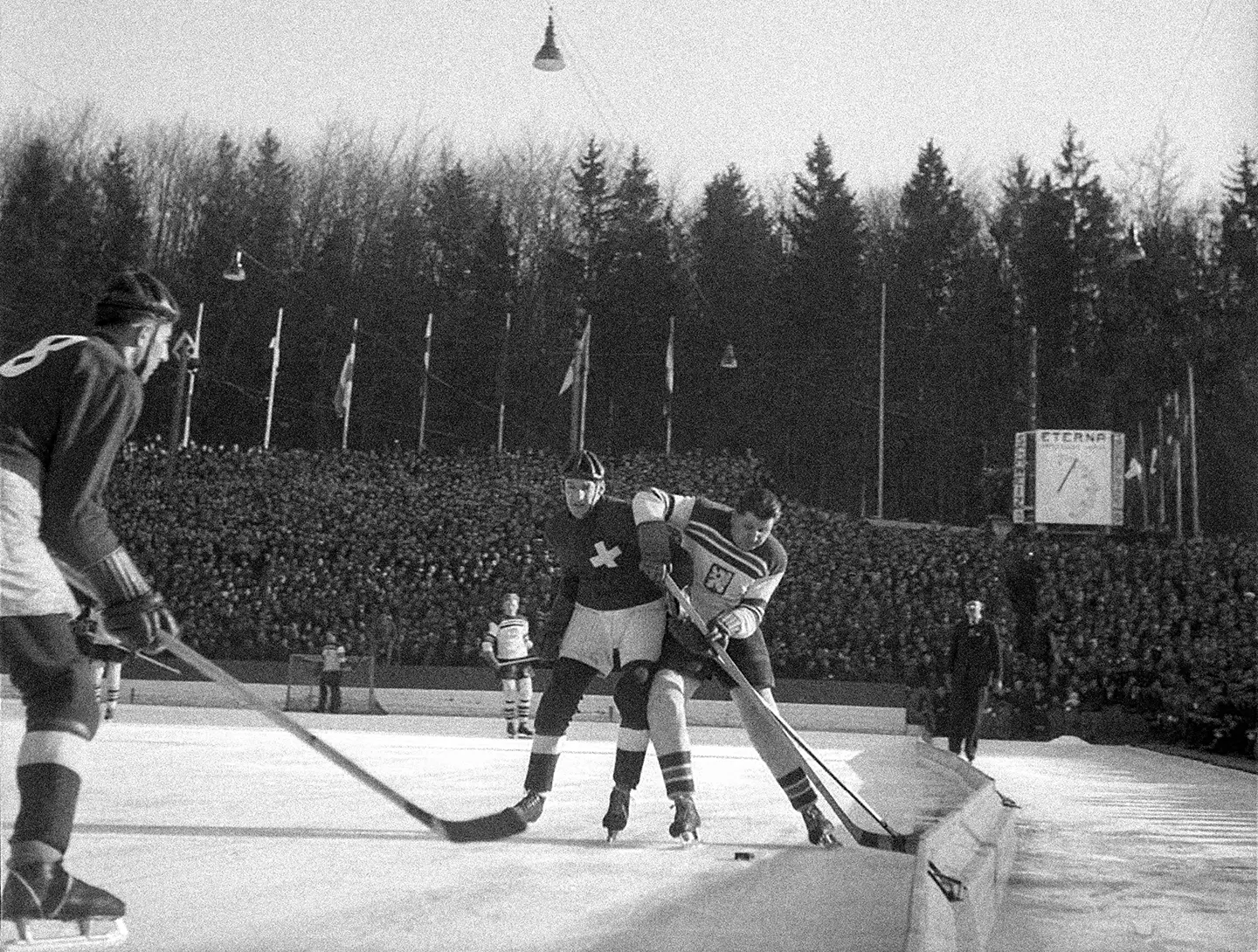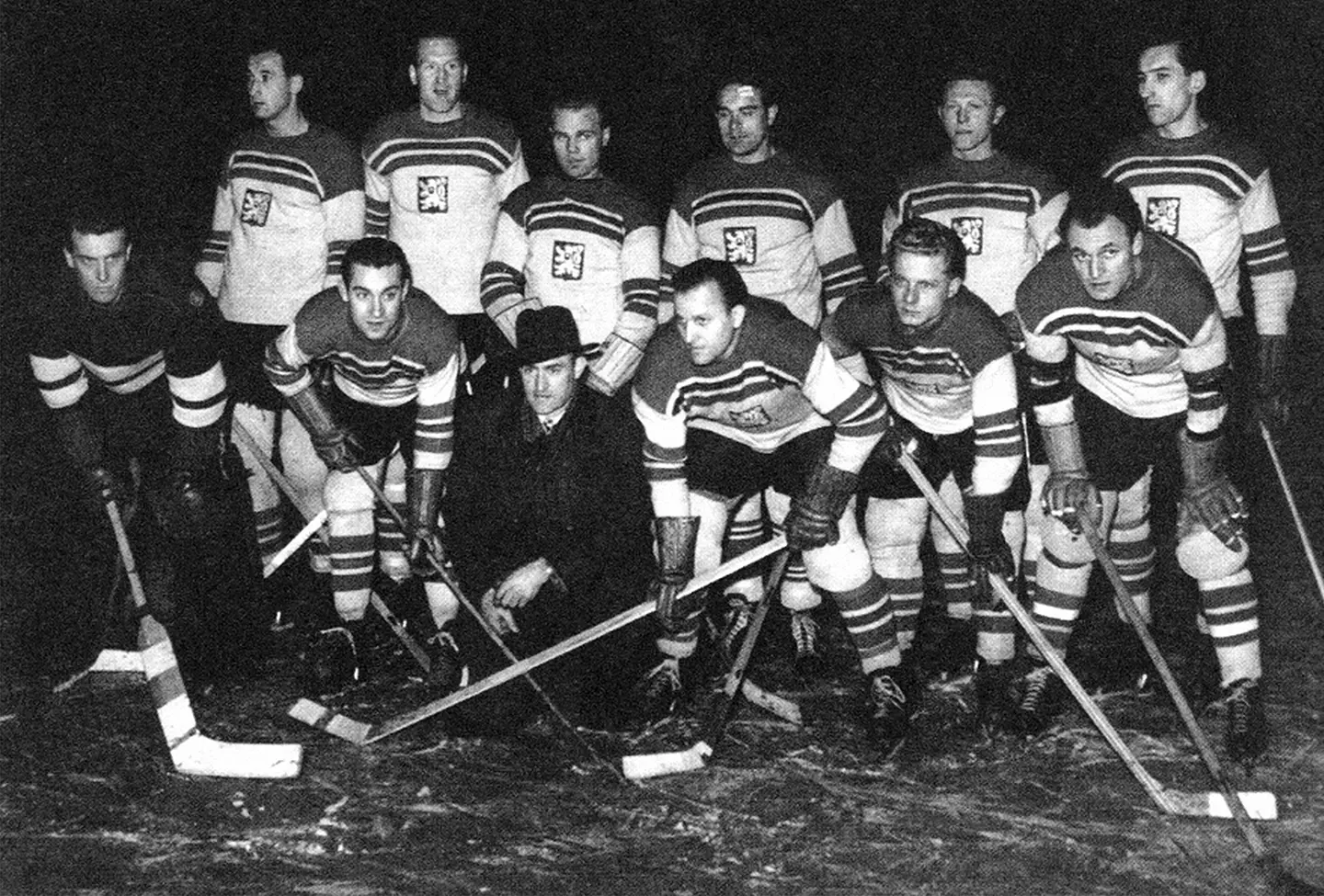Hockey, as we all know, was invented in Canada. But few people realize that the European style of hockey that has been so artfully displayed by the likes of Jaromir Jagr, Pavel Bure, and Mats Sundin was also derived from a Canadian design. Or to be more precise, the blueprint of one Canadian in particular: Mike Buckna, a hockey savant from Trail, B.C.
Born in 1913 to parents who emigrated from Slovakia to Trail in the 1890s, Buckna first earned acclaim as a high-school athlete, then as a star forward with Trail Smoke Eaters, a powerhouse in B.C. senior hockey. Like most players on the team, Buckna worked at the Cominco smelting plant.
His life’s turning point came in 1935, when he accompanied a friend on a sightseeing trip to Czechoslovakia. His first night there he attended a hockey game. The next day, Buckna, who spoke Czech and who had brought his skates with him, asked the coach of one of the teams, the oddly named Lawn Tennis Club Prague, if he could join their practice. Buckna was clearly superior to everyone and was asked to join the team. He agreed. Not only did he become the league’s top gate attraction, the 22-year-old was soon coaching the team as well. Excited by his new life, Buckna decided to leave Trail and stay in Prague.

Buckna wearing his LTC Prague uniform at the 1936 Spengler Cup in Davos, Switzerland. Photo courtesy of BC Sports Hall of Fame.
At the time Czech hockey was in its early stages. Most coaches were former tennis or soccer players, and in international games, the Czechs were often pummelled. The focus was on preventing goals, not scoring them. As Buckna later told a reporter: “They weren’t aggressive. They would give up on games and even on plays. They had never heard of forechecking. When they lost the puck, everyone used to drop back. Their defencemen never dreamed of carrying the puck or making offensive plays.”
Such attitudes were heresy for Buckna, an intense, driven individual. His son, Mike Jr., a retired businessman who lives in Milwaukee, remembers his father as “a strict disciplinarian” who possessed an uncanny sense of the game. “He saw it differently than a lot of people,” he notes. “He was thinking one step ahead all the time.”
Buckna soon began whipping his skaters into shape. He taught them the style of play perfected by the Smoke Eaters, a small club that compensated for lack of size with stellar conditioning and a finesse game that stressed quick skating and constant puck movement. The approach helped them win seven straight B.C. championships from 1926-27 to 1932-33. Under his direction, LTC Prague immediately improved.
Before long, Buckna was offered a job not just as playing-coach of LTC Prague but also as coach of the national team, plus a post overseeing the entire Czechoslovakian hockey program. Displaying a keen work ethic, he began travelling the country, instructing youngsters and organizing the game at the school level. Coaches from all over Czechoslovakia attended his coaching clinics. As a result, the system he introduced became the national style.
Buckna’s connection with the country became even tighter in 1938, when he wed Aloisie (Lola) Frolikova, a Czech tennis star. That same year at the world championship, the hockey team finished third behind Canada and Great Britain. In 1939, the Czechs finished in a tie for third with Switzerland behind Canada and the U.S. but lost the bronze to the Swiss in a one-game playoff.
While Czechoslovakia’s hockey fortunes were rising, Buckna’s former team, the Smoke Eaters, had climbed to the top of the Canadian senior ranks, copping the prestigious Allan Cup in 1938. From 1920 to 1963, the reigning Allan Cup winner represented Canada at the world championship, and so in December 1938, after playing 15 exhibition games in Canada, the Trail club embarked on an epic European tour that saw them play 54 games in 97 days in five countries, including eight tilts at the World Championship, while posting an amazing 52-1-1 won-lost record.
The victory marked only the second time a non-North American team had won the title, and it ensured Buckna’s status as a national hero.
Since no sponsor offered to supply the club with Canadian sweaters, they wore their distinctive orange-and-black Smoke Eaters garb with the belching smokestacks logo throughout the tour. By all accounts the venture was a major success, as the team played to sellout crowds, promoting Canada’s image and the Smoke Eaters brand across Europe.
At the 1939 world championship in Switzerland, the team from a tiny mining town of 9,000 continued its dominance, going unbeaten and outscoring its foes 42-1. Anatoly Tarasov, architect of the Russian hockey machine, commented in his later years that the 1939 Smoke Eaters were one of the greatest teams he had ever seen, and he copied many of their techniques when coaching.
With war looming, Buckna flew home. Back in Canada, he rejected an offer from the NHL’s Chicago Blackhawks, opting instead to play for the Smoke Eaters, who captured the B.C. championship in 1940 and 1941. Mike Jr. believes his father made the decision because Aloisie, who spoke little English and had only a small circle of friends, was unwilling to move to the U.S.
In 1946, Buckna returned to Europe and LTC Prague, where he discovered that the players he had taught before the war had become polished vets. Nine played on the Czech team that Buckna coached to a world championship in front of jubilant fans in Prague in 1947. The victory marked only the second time a non-North American team had won the title, and it ensured Buckna’s status as a national hero.
Canada, the reigning champion, did not compete at the 1947 world championship, but it did send a team to the 1948 Olympics in St. Moritz, Switzerland, where the Canadians were shocked to find that the once hapless Czechs were now their equals. Both teams cruised unbeaten through the tournament, battling to a 0-0 draw in their lone encounter, but Canada was awarded the gold due to an edge in goals differential.
The Soviet Union, which had just launched its own hockey program, did not enter the 1948 Olympic tournament, but afterward, the Czech national team was invited to Moscow to play exhibition games. Buckna, however, was denied a visa. Even so, his teachings made an impression. When the Soviets appeared at the 1954 world championship, they exhibited the fast skating and crisp passing style used by the Czechs.
Buckna was forced to flee Czechoslovakia again in 1948 after the Communist coup d’état. “We packed up, and within a week we were gone,” recalls Mike Jr., who believes his father would have been arrested if they had stayed. By this point, thousands of Czech kids were playing hockey, and the country was a hockey power. When Buckna returned to Trail, he predicted that before long the NHL would be prowling Europe in search of players, a forecast that inspired great amusement.
In 1949 in Stockholm, the Czechs beat Canada and netted the world title for a second time. The feat was doubly impressive as the Czech club had lost six of its players in a 1948 airplane crash. But the Communist authorities had come to resent the celebrity status enjoyed by the national team members and were concerned that they might defect to the West. In fact, several Czech players had defected in the months before the world championships. As a result, the Czechoslovakian government refused to send a team to the 1950 world playdowns.

The 1939 Ice Hockey World Championship in Zurich, where Czechoslovakia lost the bronze-medal game to Switzerland. Photo courtesy of Ullstein Bild DTL
Days later, the police arrested 12 members of the Czech team on charges of espionage, plotting to defect, and “slandering the republic.” All 12 were convicted, given sentences ranging from eight months to 15 years, and sent to work in uranium mines digging material used to make the Soviets’ atomic bomb. After their release, years later, many died from radiation poisoning.
Back in Trail as player-coach for the Smoke Eaters, Buckna won the 1949 B.C. championship. He then continued coaching at various levels. Following his retirement from hockey in the mid-1950s, he and his wife bought Trail’s Montana Hotel from his father, operating it until 1974. But the Czechs did not forget their mentor. In 1978, the innkeeper was invited to Prague for the world championship by the Czech Ice Hockey Association. During his stay, Buckna was honoured at a banquet as “the father of Czechoslovakian hockey.” It was not the only tribute he received. The Swedish Ice Hockey Association presented Buckna with a large scroll, inscribed to “the man who made the greatest achievement in European ice hockey.”
Even so, it was not until 2004, eight years after his death, that Buckna was inducted into the International Ice Hockey Federation Hall of Fame, and after 13 Czech players had been inducted. Sadly, there has never been a push to get him elected to the Hockey Hall of Fame as a builder, and when Canadian hockey experts gather to discuss the evolution of the European game, his name is never mentioned. Why remains a mystery.
Read more from our Autumn 2025 issue.









